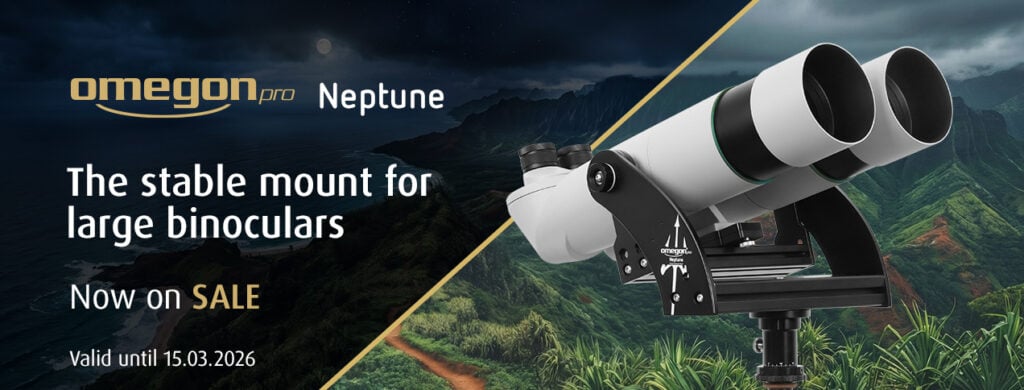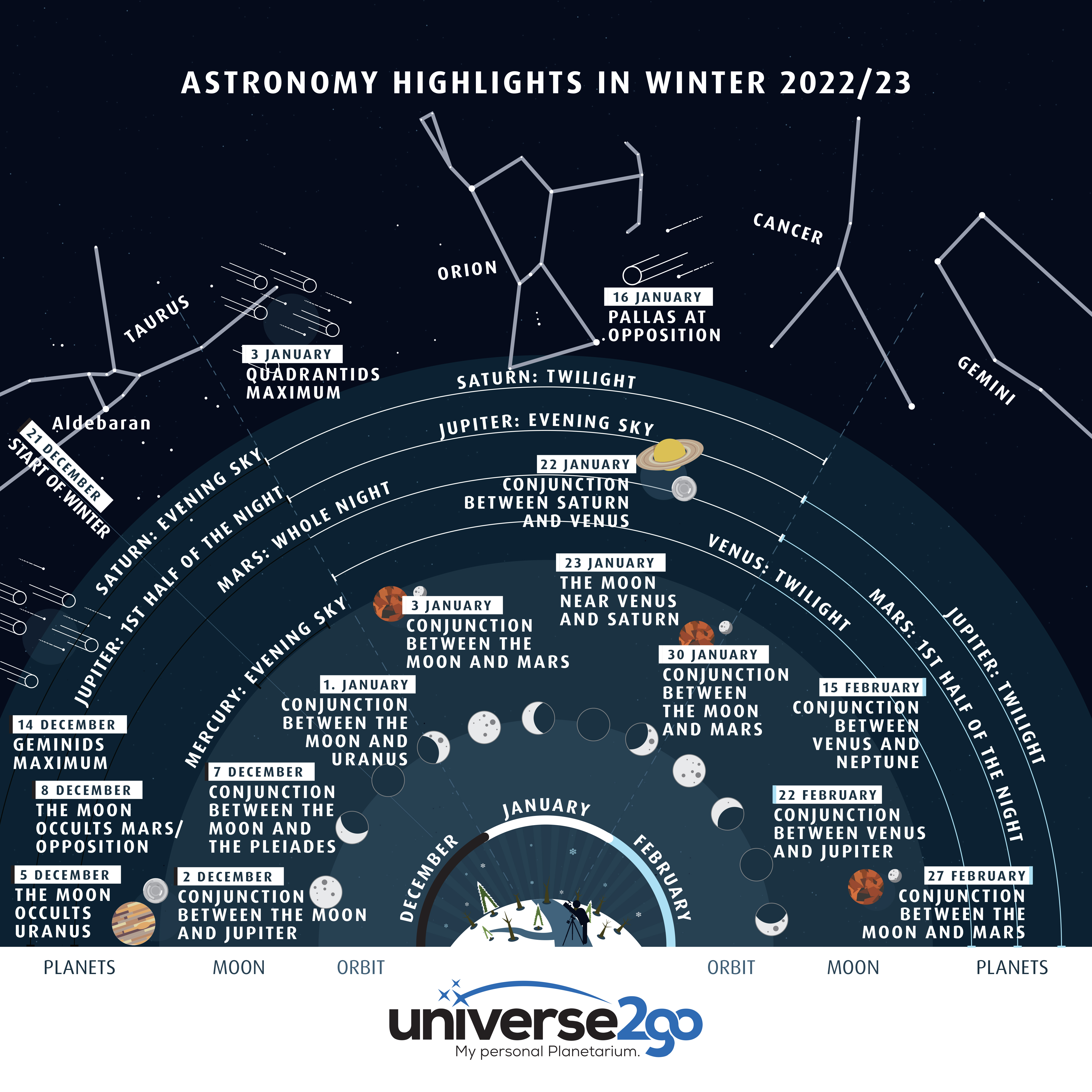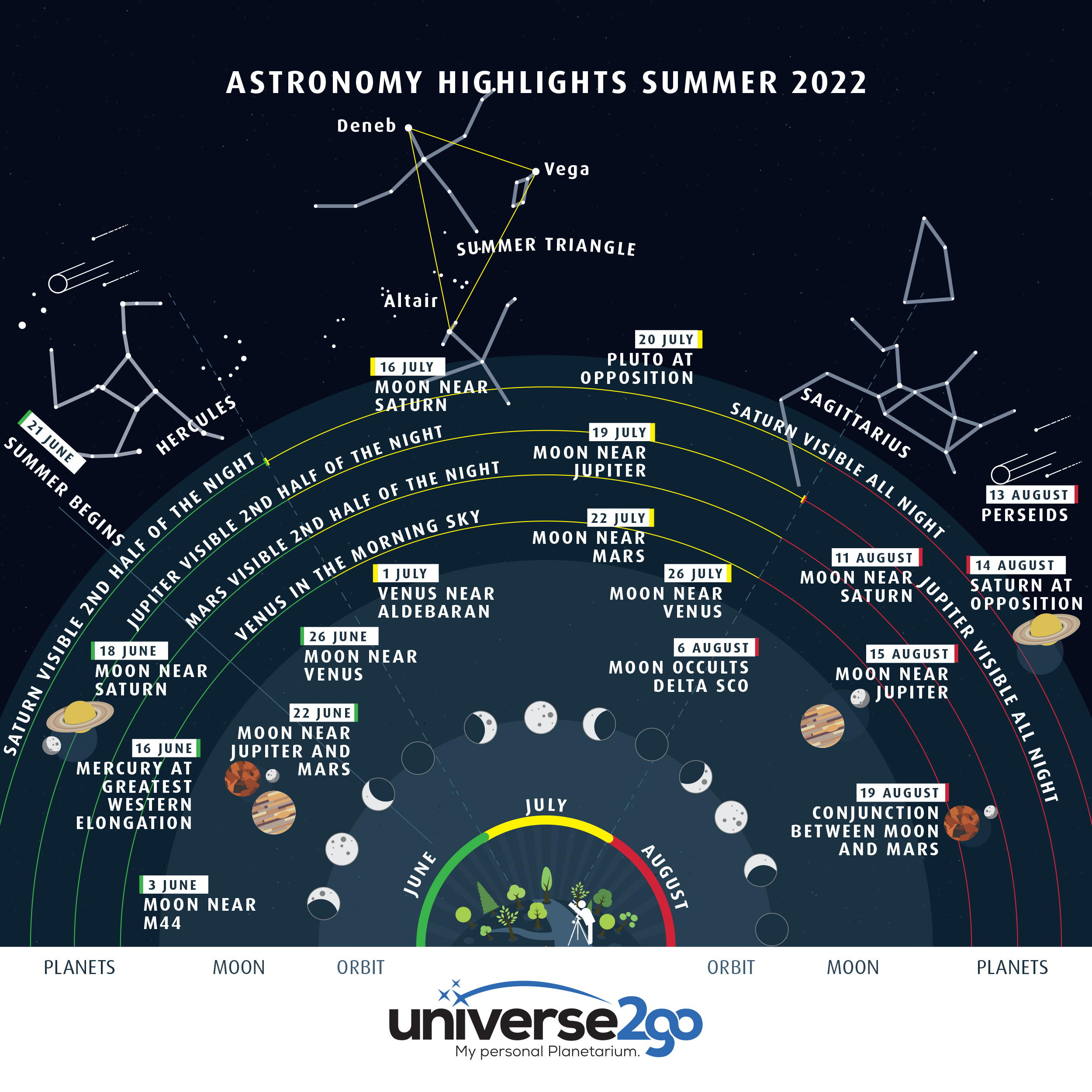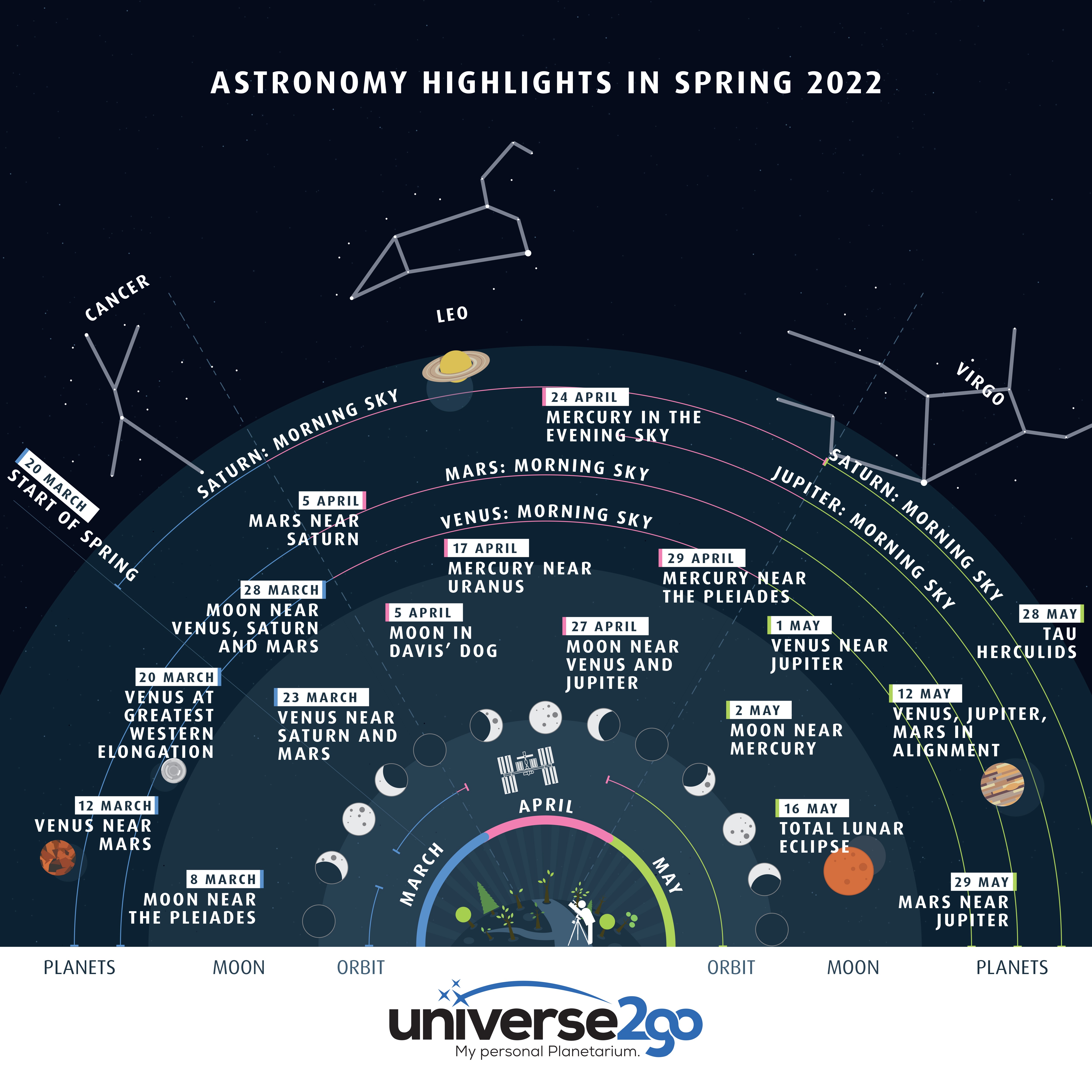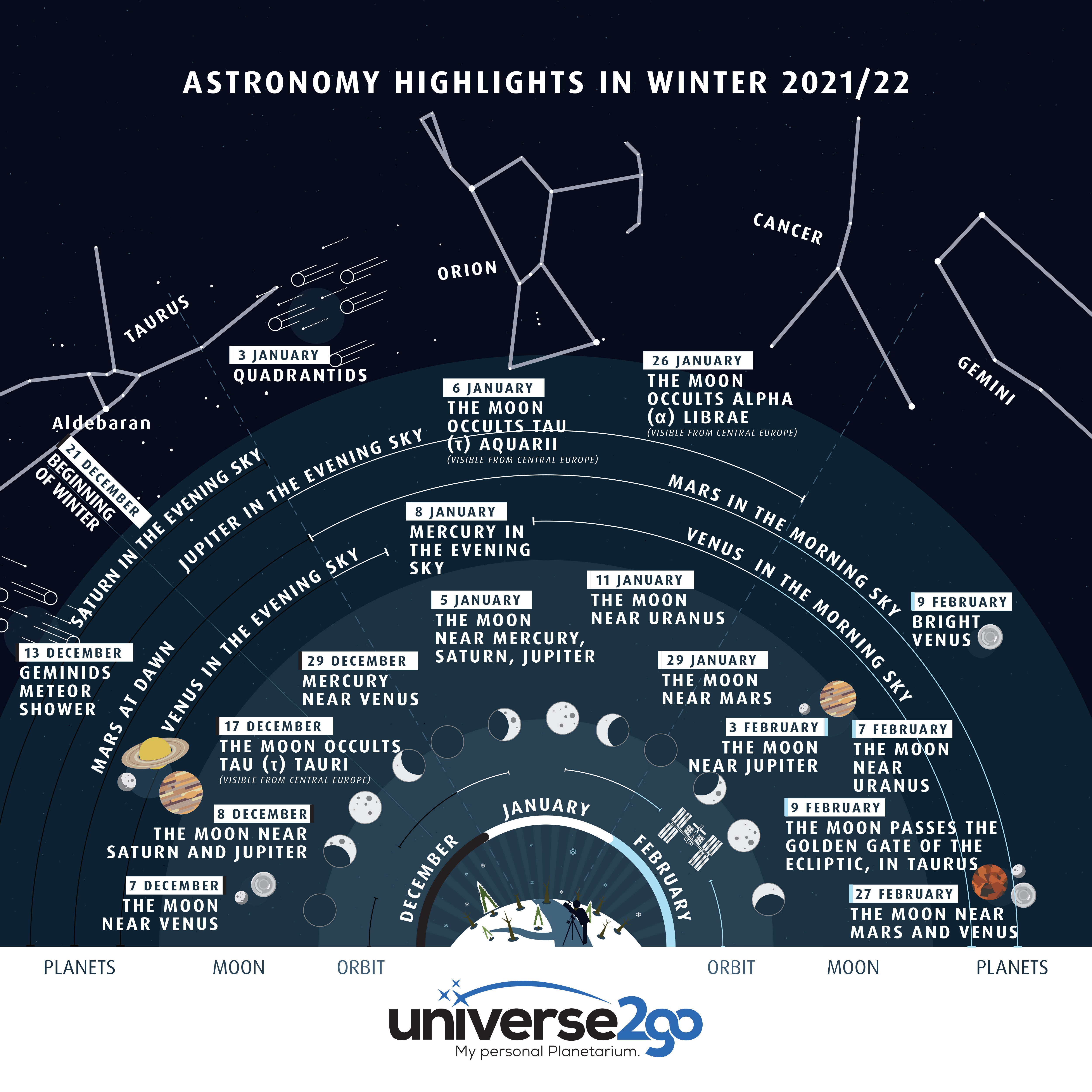Observing in summer! This means warm temperatures, but also some interesting constellations and the visible part of the Milky Way. In this infographic you will find all the important astronomical events in the summer of 2023 that you really should not miss. How about Saturn at opposition, or the Perseids shooting stars which we can enjoy this year without any interference by the Moon?
Whether you are an experienced amateur astronomer or a complete beginner to the field of astronomy: the astronomy events in our infographic offer something for everyone.
We wish you lots of observing fun!
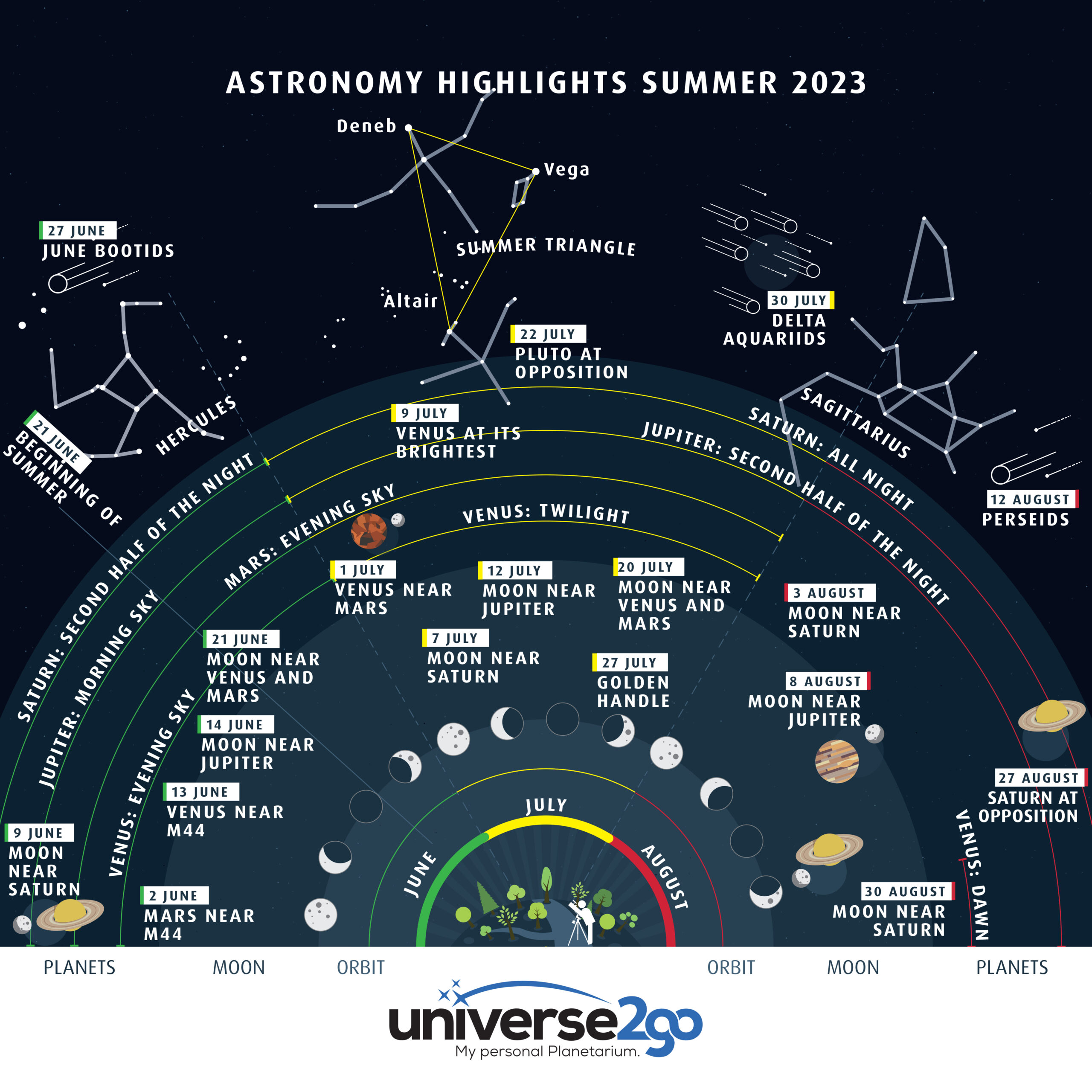
02/06 Mars near M44
There is an interesting encounter in the evening sky at the moment: Mars, the Red Planet, can be found close to the M44 cluster, and the pair offers a beautiful view. The constellation is easy to see, especially at dusk close to the western horizon. But it is not only Mars that is attracting attention: at a distance of around 10 degrees, Venus is also close by.
09/06 Conjunction between the Moon and Saturn
A very special performance is awaiting us in the sky this morning: the Moon and Saturn meet in the constellation of Aquarius and provide us with an impressive sight. Jupiter can also be seen nearby which rounds off the spectacle perfectly.
13/06 Venus near M44
On 13 June, Venus will be in close proximity to the open cluster M44, which is also known as the Beehive Cluster. It’s great when you can combine such an astronomical event with some deep sky observation.
14/06 Conjunction between the Moon and Jupiter
On 14 June, just four days after its meeting with Saturn, the Moon will be spending some time with the planet Jupiter. This beautiful dawn sight is worth getting up early for, because the Moon appears as a delicate sickle and will soon reach its new Moon phase.
21.06 Beginning of summer
Summer begins with the summer solstice on 21 June. In the northern hemisphere this means that the Sun reaches its highest point in the sky. We cannot actually observe this astronomical event, but we are now experiencing the longest days and the shortest nights.
21/ 22.06 Conjunction between Venus and Mars
21 June is a day that you should be certain to make a note of in advance. This evening, above the western horizon, Venus and Mars meet up with the narrow crescent Moon. This trio is especially impressive when it is not yet completely dark, and we can also enjoy the twilight sky.
27.06 June Bootids
From 23 to 28 June you can observe the June Bootids meteor shower. These shooting stars radiate from a point in the constellation of Boötes and fizzle comparatively slowly across the sky. The number of meteors is small but also variable. This means that it is particularly interesting to take a closer look.
01.07 Conjunction between Venus and Mars
Our two neighbouring planets, Venus and Mars, meet on 1 July. These two celestial bodies differ greatly in brightness, which makes them especially interesting to observe. You should not miss this opportunity if you are a big Mars fan, because the Red Planet will disappear from the celestial stage this month, and remain invisible for the rest of the year.
07.07 Conjunction between the Moon and Saturn
The Moon and Saturn rise above the horizon at the beginning of the second half of the night, and accompany us through till sunrise. Both celestial bodies can be found in the constellation of Aquarius.
09.07 Venus at its brightest
Venus reaches its maximum brightness on 9 July, and looks almost like a spotlight in the sky – an impressive spectacle for amateur astronomers.
12.07 Conjunction between the Moon and Jupiter
Jupiter rises on 12 July at 01:23, and reveals itself beside a slim, waning crescent Moon.
20.07 Conjunction between the Moon, Venus, and Mars
Another fascinating event awaits us in the night sky on 20 July. The wafer-thin crescent Moon approaches Venus and, together with Mars, forms an attractive group of three. However, you will need an uninterrupted view towards the horizon to successfully observe this. If you want to enjoy this sight or even take pictures, you should find a good spot as early as possible. A tip for the professionals: the planet Mercury is also located around 10 degrees west of Venus.
22.07 Pluto at opposition
An astronomical event for more advanced astronomers: Pluto, the dwarf planet former classified as a planet, is at opposition to the Sun on 22 July. With a brightness of magnitude 14, you can only detect and observe it with a large telescope. A location map is advisable! Astrophotographers can take advantage of a good photo opportunity since Pluto is close the M75 cluster.
27.07 Golden Handle
We can see the Golden Handle on the Moon on the evening of 27 July. It appears when the waxing Moon is exactly 83 percent illuminated, which happens around 10 days after the new Moon. As the light phenomenon takes place, a handle shape emerges on the dark side of the Moon’s terminator.
30.07 Delta Aquariids
The Delta Aquariids is a meteor shower that originates from the region of the constellation Aquarius, and is visible from 23 to 28 July. We will be able to marvel at up to 25 shooting stars per hour! The optimal observing window is in the early hours of the morning, after the Moon has set.
03.08 Conjunction between the Moon and Saturn
An interesting encounter: the Moon nears the planet Saturn. The ringed planet will reach its opposition to the Sun this month and is therefore an especially good target to observe.
08.08 Conjunction between the Moon and Jupiter
In the early morning hours, we can enjoy the autumn and the first winter constellations in the night sky. Our largest planet, Jupiter, is to be found right in the middle of them. On the 8th of the month, the Moon approaches the gas giant and they make an arresting pair in the night sky.
12-13.08 Perseids
A view of the Perseids is the top astronomy event not just for astronomers, but also for anyone who is interested in the night sky. An especially large number of meteors fall from the sky over the course of an evening, and everyone can enjoy guessing which direction the next light trail will appear from. It’s finally time to see them again during the night from 12 to 13 August. Grab a blanket or a lounger and something warm to drink, and enjoy the starry sky. If you’re lucky, you’ll see up to 100 meteors per hour this evening. This year there is an added plus: it is almost new Moon, so the night is particularly dark.
27.08 Saturn at opposition
The ringed planet Saturn is at opposition to the Sun on 27 August and can be observed all night long – an absolute highlight for any amateur astronomer.
30.08 Conjunction between the Moon and Saturn
In the night from 30 to 31 of the month, the Moon and Saturn meet at a distance of around 3 degrees. Despite the full Moon, it is always worth observing Saturn.

